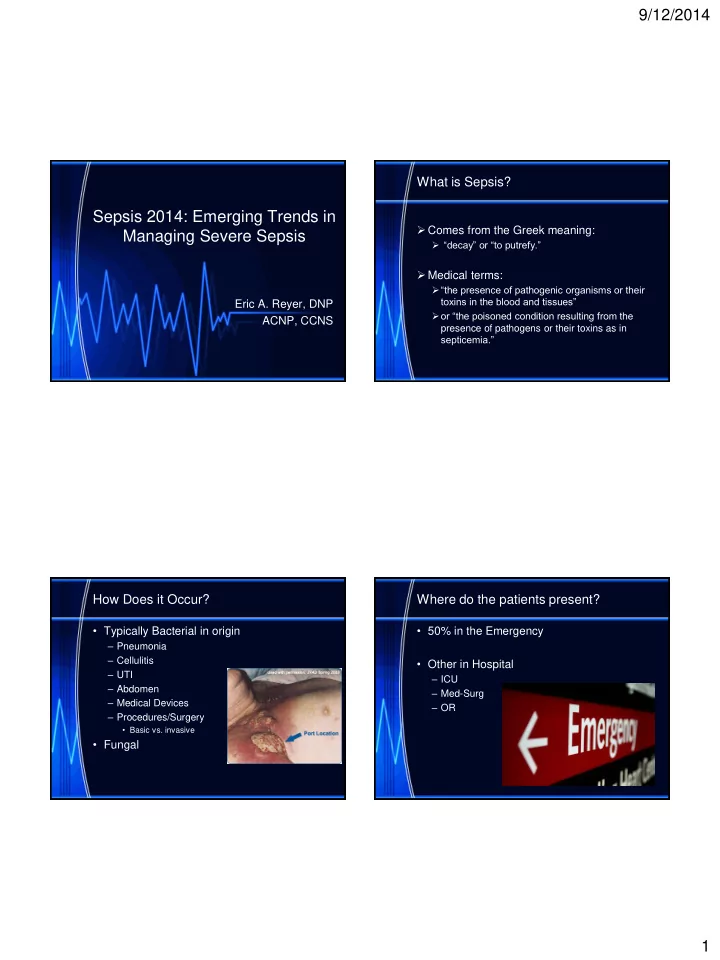

9/12/2014 What is Sepsis? Sepsis 2014: Emerging Trends in Comes from the Greek meaning: Managing Severe Sepsis “decay” or “to putrefy.” Medical terms: “the presence of pathogenic organisms or their toxins in the blood and tissues” Eric A. Reyer, DNP or “the poisoned condition resulting from the ACNP, CCNS presence of pathogens or their toxins as in septicemia.” How Does it Occur? Where do the patients present? • Typically Bacterial in origin • 50% in the Emergency – Pneumonia – Cellulitis • Other in Hospital – UTI – ICU – Abdomen – Med-Surg – Medical Devices – OR – Procedures/Surgery • Basic vs. invasive • Fungal 1
9/12/2014 Hospital Avoidance Incidence of Sepsis • PPE Approximate Cases/Year 800,000 – Personal Protective Equipment • Hand washing Severe sepsis 600,000 • CAUTI 800,000 – Catheter Associated Urinary Tract Infection 400,000 • VAP Septic shock – Ventilator Associated Pneumonia 400,000 200,000 • CLABSI Deaths from septic shock 200,000 – Central line-associated Bloodstream Infections 0 Sepsis and sequelae are a leading cause of death in ICU http://www.medicare.gov/hospitalcompare/search.html Mortality in septic shock remains at 35 - 50% -unchanged since advent of antibiotics (from 55 - 75%) Incidence/Mortality of Sepsis Mortality of Sepsis • According to the US CDC septic shock is the Mortality Incidence 13th leading cause of death in the United 300 250000 States, and the #1 cause of deaths in 250 intensive care units. Deaths/Year 200000 Cases/100,000 200 150000 150 100000 100 50000 50 0 0 AIDS Breast AMI Severe AIDS Breast 1st MI Severe Cancer Sepsis Cancer Sepsis 2
9/12/2014 Endothelium Hemodynamics 101 COAGULATION CASCADE PAI-1 Factor VIIIa Tissue Factor IL-6 Bacterial, viral, fungal or IL-1 parasitic TNF infection/endotoxin Factor Va Suppressed Monocyte fibrinolysis TAFI THROMBIN Fibrin clot Bacterial, viral, fungal or parasitic infection/endotoxin Fibrin Neutrophil Tissue Factor IL-6 Inflammatory Response Thrombotic Response Fibrinolytic Response to Infection to Infection to Infection Identification of Sepsis Hemodynamic Effect of Sepsis SCCM and Surviving Sepsis Campaign Suspicion of infection (i.e. UTI, pneumonia, abscess/cellulitis, etc.) Capillary – AND SIRS- Two or more of the following: (Systemic Inflammatory Response Syndrome) Arteriole Venule Temperature ≥100.4 o F (38 o C) or <96.8 o F (36 o C); Rectal temp if altered mental status Neutrophil Aggregation Heart Rate >90 bpm “Clotting” Vasodilation “Container” Respiratory Rate >20/min or Mechanical Ventilation Cell Endothelial Cell “Tissue Oxygenation” Destruction Altered Mental Status (ED Specific) “Leakage” (Leukocytosis) 3
9/12/2014 Progression of Sepsis Differentiating Severe Sepsis TWO OF THE FOLLOWING: Temperature ≥100.4 o F (38 o C) or <96.8 o F (36 o C); Rectal temp if altered mental status Heart Rate >90 bpm Respiratory Rate >20/min or Mechanical Ventilation Altered Mental Status AND SBP<100mmHg or MAP<65mmHg after initial fluid bolus Lactate ≥4 mmol/L Lactate Early Goal Directed Therapy • Produced when damage is done to cells EGDT is an algorithmic approach of hemodynamic optimization that aims to restore the balance between oxygen • Lack of perfusion supply and demand in cases of severe • Lack of Oxygen (anaerobic metabolism) sepsis or septic shock within the first 6 hours of ED care. • Physical damage Early hemodynamic optimization requires the monitoring of CVP, arterial blood pressure and ScvO 2 Studies demonstrating the efficacy of early goal-directed therapy in the treatment of severe sepsis and septic shock have targeted central venous oxygen saturation (ScvO2) as a key indicator of potential sepsis . 16 4
9/12/2014 Insert CVC with ScvO2 Sepsis Management • CVP monitoring • Early Goal Directed Therapy – Transducer – Quick Identification • ScvO2 monitoring – Initial Labs and Fluid Resuscitation – Central Venous Catheterization 1. Achieve and Maintain CVP ≥ 8 mmHg 2. Achieve and Maintain MAP ≥ 65 mmHg – Requires advanced provider to place 3. Achieve and Maintain S c VO 2 ≥ 70% – Catheter more expensive BUT saves 40,000 per patient that develops sepsis! Lactate clearance Mortality and EGDT Sepsis Screening NNT to prevent 1 event (death) = 6-8 • Absolutely crucial to Identify early Standar ard therapy py 60 60 EGDT 50 50 Mortality (%) 40 40 • ED Triage 30 30 • ICU • Floor 20 20 • OR 10 10 0 In In-hosp spital 28-day 28 y 60 60-day y mortality y mortality mortality y (all patients) s) Rivers E, Nguyen B, Havstad S, et al. Early goal-directed therapy in the treatment of severe sepsis and septic shock. N Engl J Med 2001; 345:1368-1377 5
9/12/2014 Other Considerations Barriers to Implementation? • Antibiotics in 1 Hours (Severe) • Providers • Urine Output monitoring – No time to insert central line – Not skilled to place IJ/Subclavian • Steroids – “I’m a physician, I know how to treat sepsis. I • Glucose Control don’t need a fancy machine to tell me what to do.” • CRRT • Nutrition • DVT/Stress Ulcer Prophylaxis Barriers to Implementation? Other Methods of Treatment • Nursing • Arterial Line CCO – Poor screening – Mainly use Stroke Volume Variation (SVV) • Computerized Charting? – Lack of education 6
9/12/2014 Other Methods Other Methods • Bioreactance (older bioimpedance) • Thermodilution – Arterial – PA Catheter Other Methods NEJM Sepsis Trial March 2014 • Lactate Clearance Research – Now a part of EGDT – NOT recommended as stand alone treatment • Flawed study- Small Much sicker patients in the • Only ED Original trials • 10% clearance Hawthorne effect? Clinicians • 6 hours only aware of all 3 arms • Only inhospital Adherence not 100% in EGDT 7
9/12/2014 QUESTIONS????? Eric.reyer@duke.edu EXED130 8
Recommend
More recommend